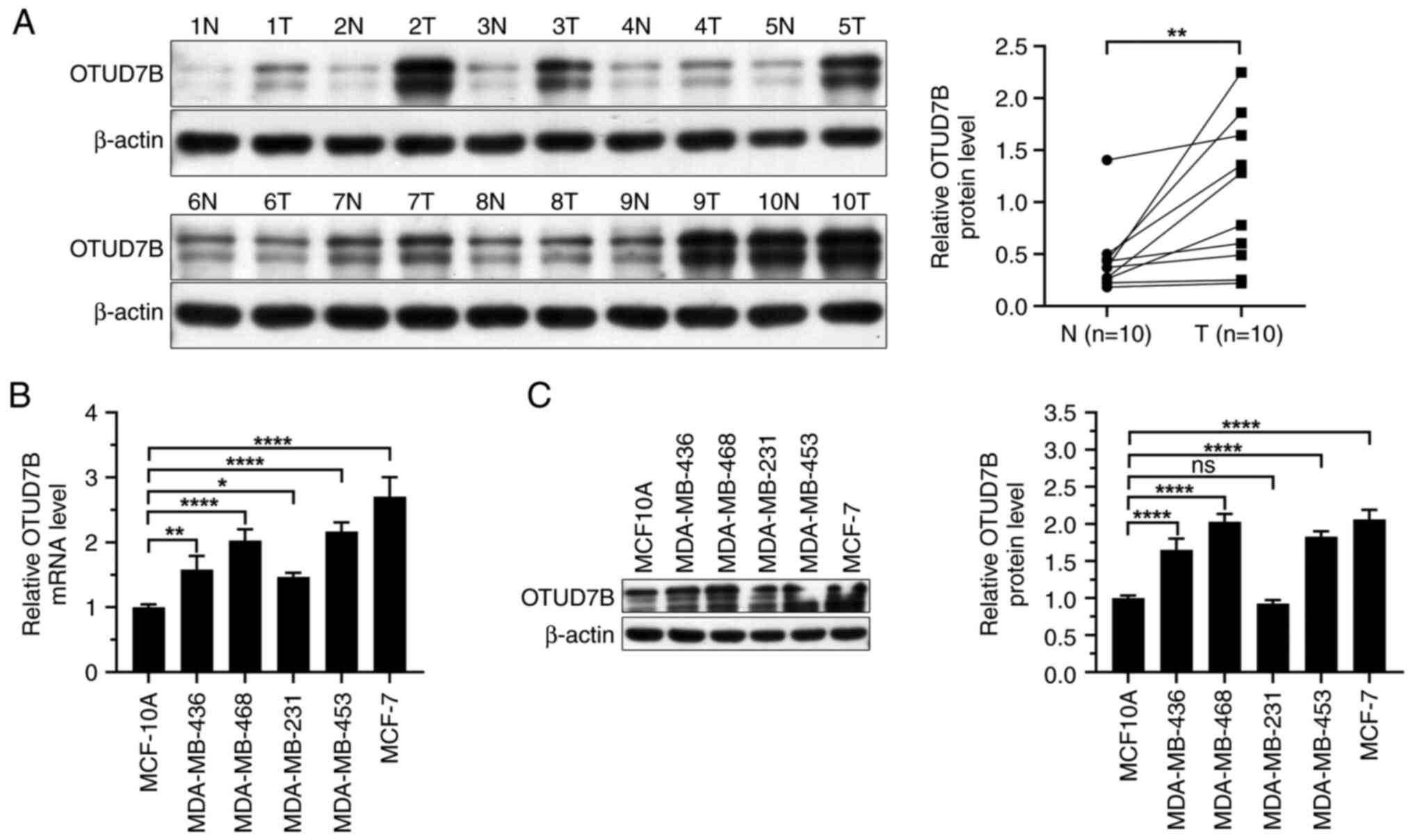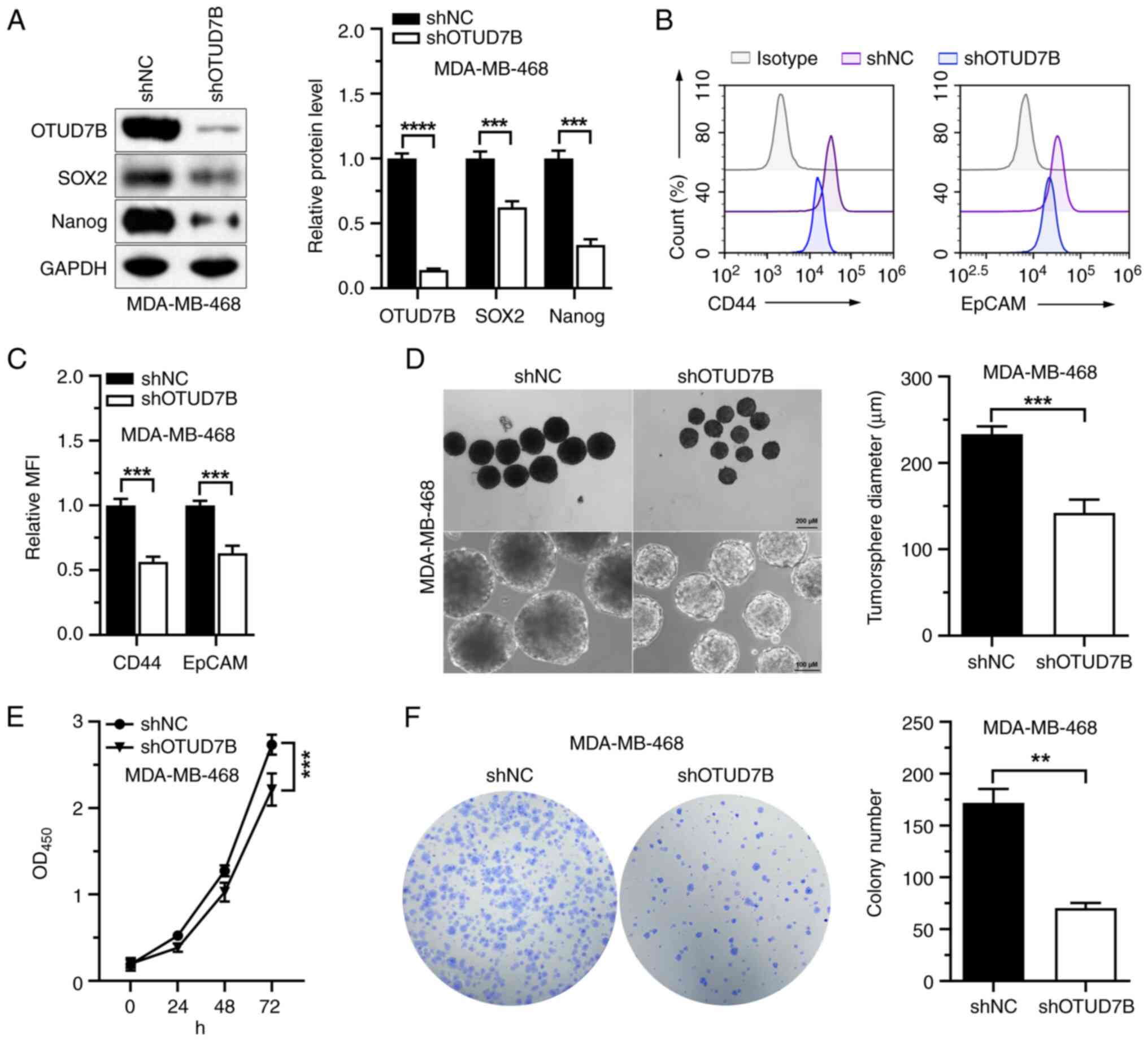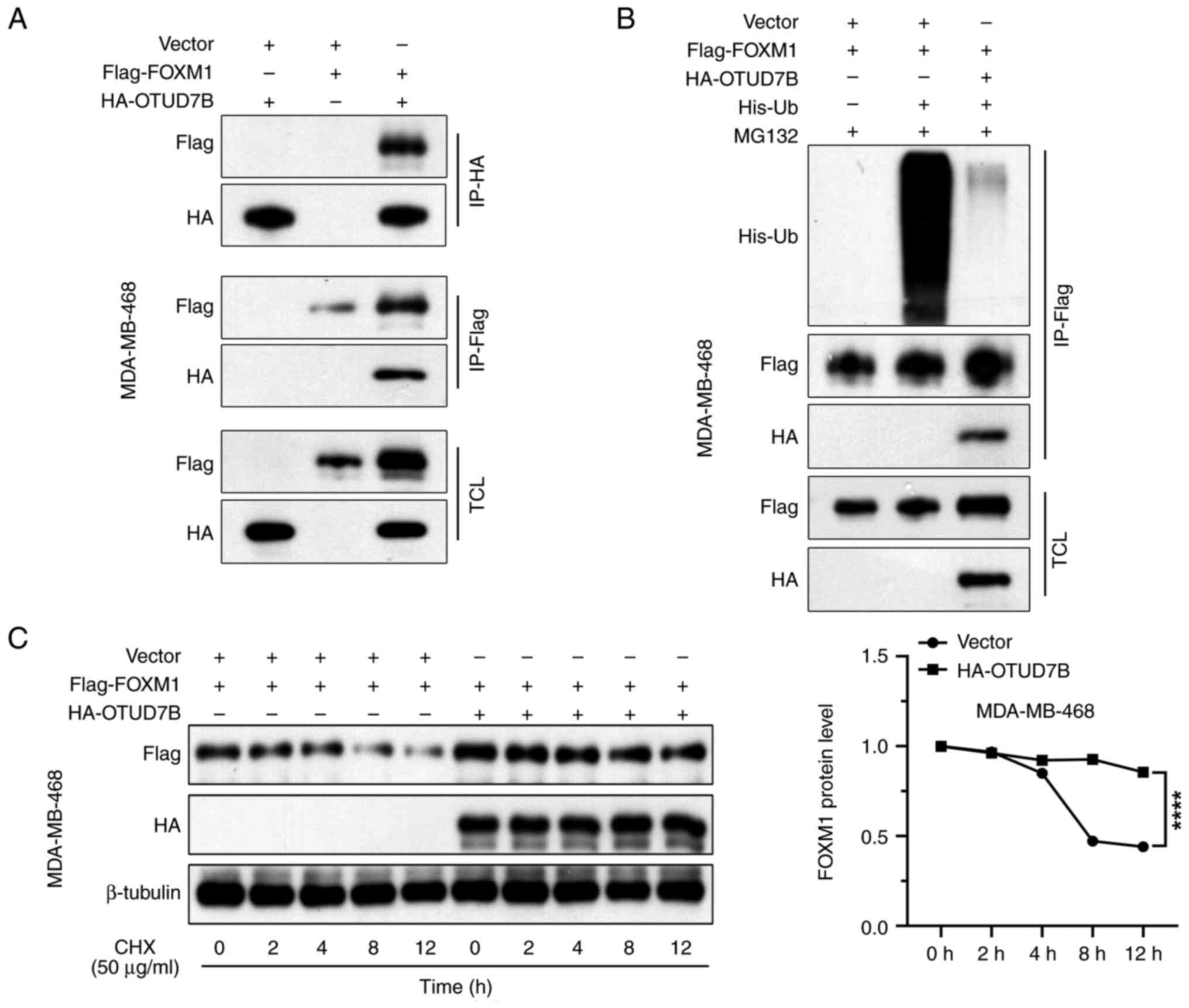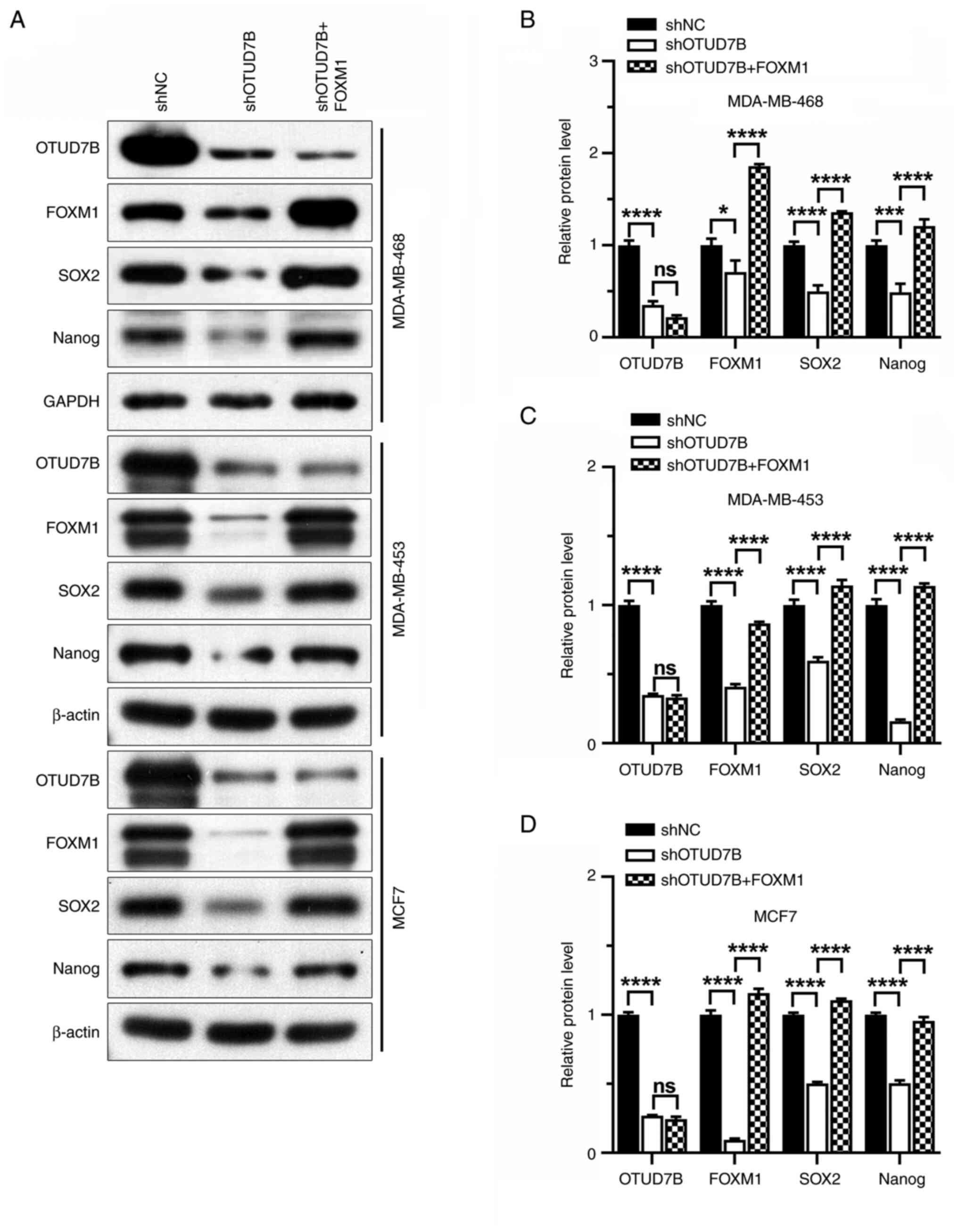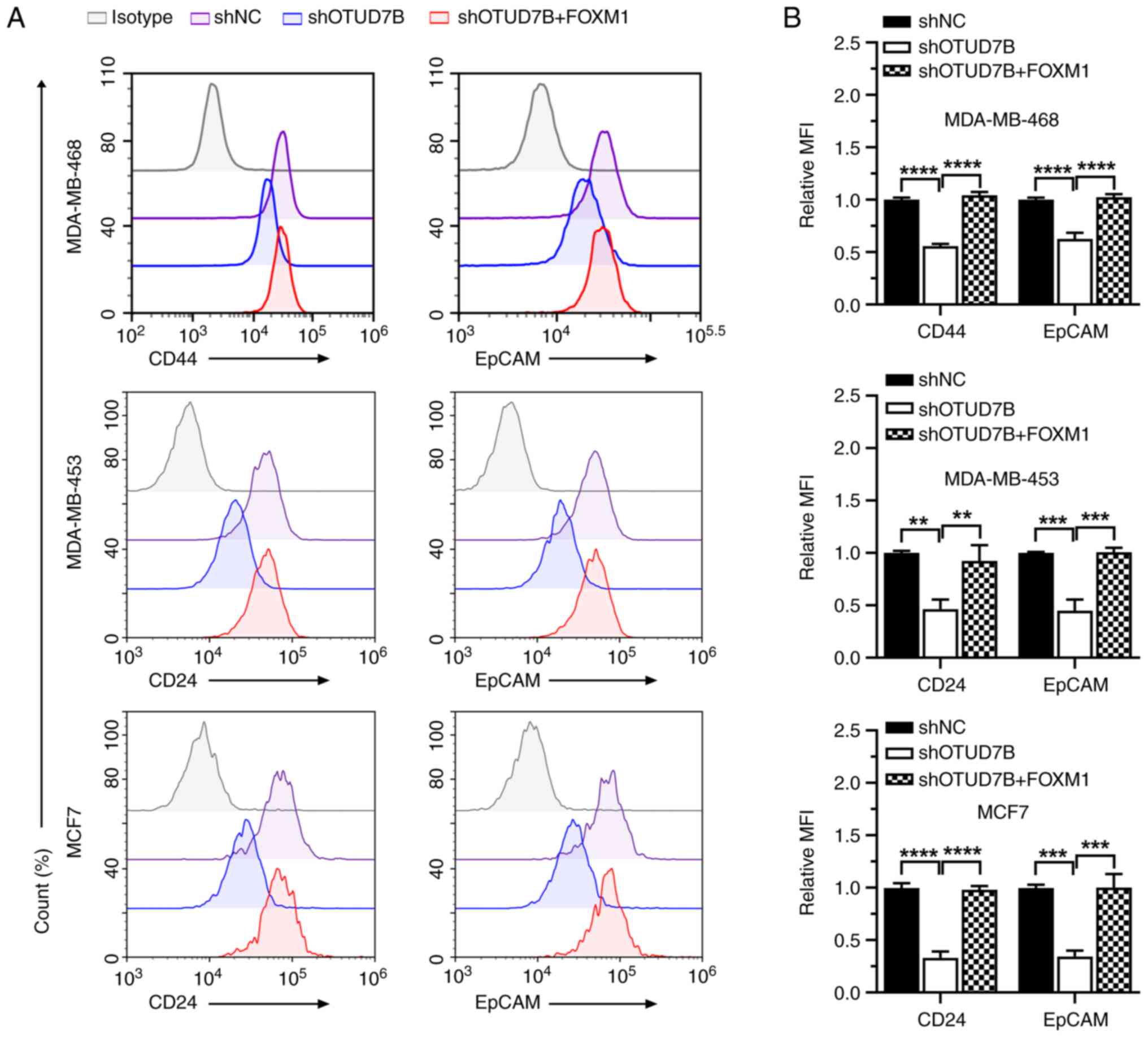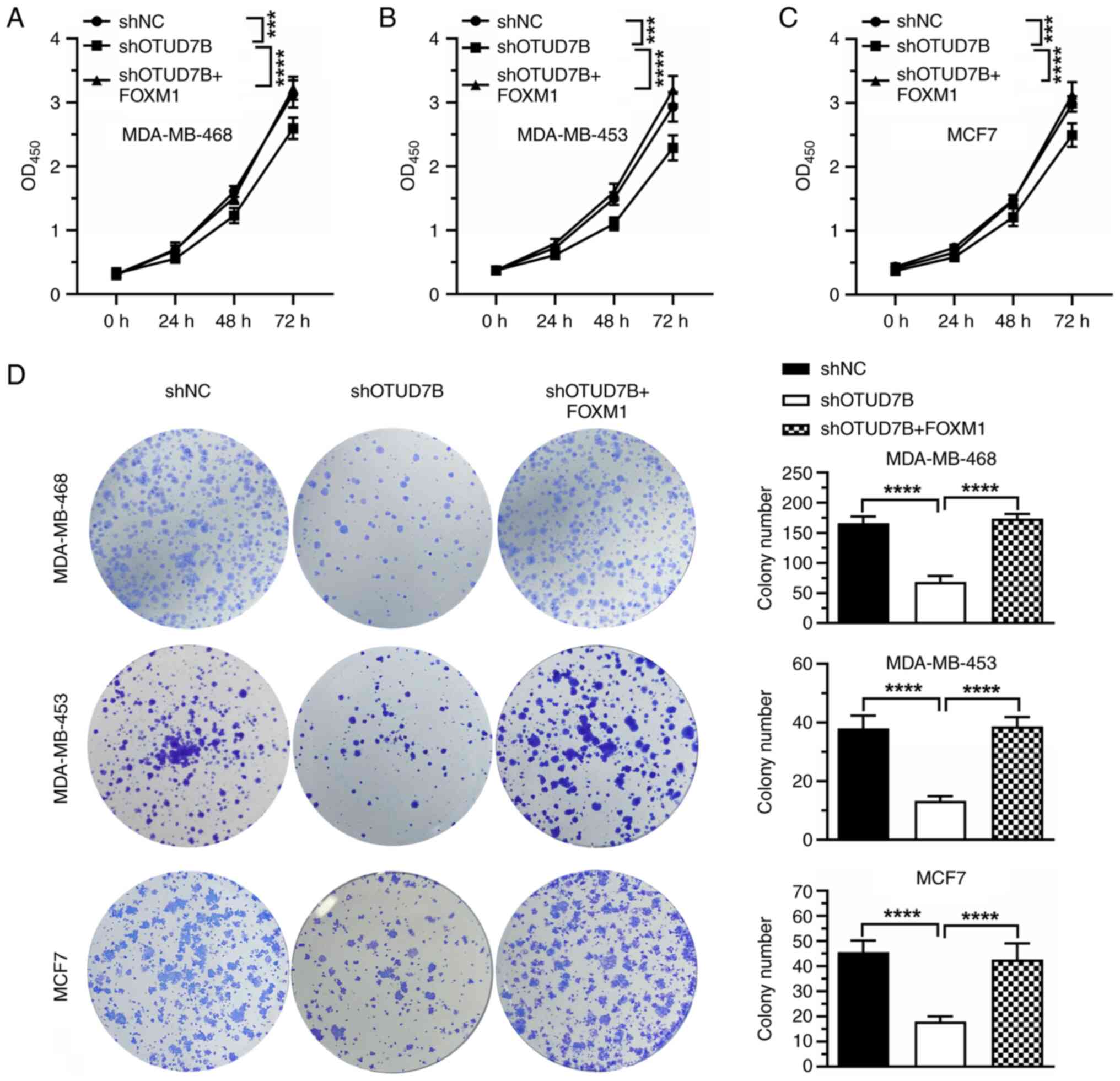OTUD7B knockdown inhibits the proliferation and stemness of breast cancer cells by destabilizing FOXM1
- Authors:
- Published online on: January 16, 2024 https://doi.org/10.3892/ol.2024.14235
- Article Number: 102
-
Copyright: © Wang et al. This is an open access article distributed under the terms of Creative Commons Attribution License.
Abstract
Introduction
Breast cancer is the most common cancer type and a leading cause of cancer-related death in women worldwide. Breast cancer is clinically classified into four subtypes that are characterized by the expression of hormone receptors: Estrogen receptor (ER)-positive, progesterone receptor (PR)-positive, human epidermal receptor 2 (HER2)-positive, and triple-negative for ER, PR and HER2 (1,2). Breast cancer is treated by various methods, including surgery, chemotherapy, radiotherapy and endocrine therapy (3,4). For early-stage breast cancer, there is a good chance of patients achieving cancer-free status following multimodal therapy (3). By contrast, advanced breast cancer is typically regarded as incurable, with patients surviving for only 2–4 years (5). Thus, there is an urgent need to develop novel therapies and drugs that can prolong survival and improve the quality of life of patients with advanced breast cancer.
Deubiquitinases are components of the proteasome system that remove conjugated ubiquitin molecules from target proteins, and thus regulate their stability and bioactivity (6). Deubiquitinases are involved in several biological processes related to cancer development, including proliferation, cell cycle progression, apoptosis and metastasis (7). Increasing evidence has shown that deubiquitinases contribute to breast cancer growth, metastasis, immunosuppression, chemosensitivity and radiosensitivity (8). OTU domain-containing 7B (OTUD7B), a deubiquitinase is a member of the A20 subgroup of the ovarian tumor protein superfamily, which is often dysregulated in human cancer and may serve as a valuable prognostic predictor (9–14). In ERα-positive breast cancer, OTUD7B deubiquitylates ERα, leading to its stabilization; through this mechanism, OTUD7B promotes the proliferation of breast cancer cells (15). In ERα-negative breast cancer, silencing OTUD7B markedly inhibits the migration and invasion of cancer cells in vitro, and significantly impairs lung metastasis in vivo (16). Furthermore, high OTUD7B expression is associated with poor paclitaxel response in patients with triple-negative breast cancer (17).
In the present study, co-immunoprecipitation (co-IP) assay was used to investigate whether OTUD7B interacts with forkhead box protein M1 (FOXM1) and reduces FOXM1 ubiquitination to stabilize the FOXM1 protein. FOXM1 is a proliferation-specific transcription factor that is involved in the initiation, progression, metastasis and drug resistance of breast cancer (18). Furthermore, the present study investigated whether OTUD7B inhibits the proliferation and stemness of breast cancer cells by regulating the protein stability of FOXM1.
Materials and methods
Cell culture and tumor tissues
MCF-10A, MDA-MB-436, MDA-MB-231, MDA-MB-468, MDA-MB-453 and MCF-7 cells were obtained from Xiamen Immocell Biotechnology Co., Ltd., and were cultured in Dulbecco's modified Eagle's medium (Gibco; Thermo Fisher Scientific, Inc.) containing 10% fetal bovine serum (Gibco; Thermo Fisher Scientific, Inc.). Cells were cultured at 37°C and 5% CO2 in an incubator.
A total of 10 pairs of breast cancer tissue samples and adjacent normal tissue samples (1 cm away from the edge of the tumor and free of tumor cells) were obtained from Sanming First Hospital Affiliated to Fujian Medical University (Sanming, China). The age range of the 10 female patients was 43–62 years (mean age, 53±6.5 years). All of the patients did not receive any other treatment, such as chemotherapy, target therapy or other preoperative treatment, except for surgical operation.
Plasmid construction
Plasmid encoding His-ubiquitin (His-Ub) was obtained from Xiamen Anti-HeLa Biological Technology Trade Co., Ltd. The plasmids encoding hemagglutinin (HA)-OTUD7B and Flag-FOXM1 were constructed by subcloning OTUD7B and FOXM1 cDNA into pCDNA3.1-HA and pCDNA3.1-Flag vectors (Xiamen Anti-HeLa Biological Technology Trade Co., Ltd.), respectively. FOXM1 cDNA was also inserted into plv-EF1a-MCS-c-Flag-bsd vector (Xiamen Anti-HeLa Biological Technology Trade Co., Ltd), and the resulting plasmid was named plv-Flag-FOXM1, which was used to produce stable OTUD7B-knockdown and FOXM1-overexpression cells. Plasmids encoding a short hairpin (sh)RNA targeting OTUD7B (shOTUD7B) and a negative control shRNA (shNC) were constructed using the pLKO.1 vector (Xiamen Anti-HeLa Biological Technology Trade Co., Ltd). The sequences for plasmid construction are listed in Table I.
To determine the knockdown or overexpression efficiency of plasmids in different breast cancer cells, MDA-MB-468, MDA-MB-453 and MCF7 cells (2×106 cells/well) were cultured in six-well plates and 5 µg shNC, shOTUD7B, pCDNA3.1 vector, HA-OTUD7B or Flag-FOXM1 were transfected into cells using Lipofectamine® 2000 (Invitrogen; Thermo Fisher Scientific, Inc.) according to the manufacturer's instructions. After 24 h, cells were collected for western blotting. The results of which showed that plasmids encoding Flag-FOXM1 or HA-OTUD7B markedly increased the expression of FOXM1 or OTUD7B in cells, whereas shOTUD7B markedly decreased the expression of OTUD7B in cells. Notably, shOTUD7B-1 had the most significant effect and was thus used in subsequent experiments (Fig. S1).
Construction of stable OTUD7B-knockdown cell lines and OTUD7B-knockdown and FOXM1-overexpressing cell lines
Stable OTUD7B-knockdown MDA-MB-468, MDA-MB-453 and MCF7 cells; and stable OTUD7B-knockdown and FOXM1-overexpressing MDA-MB-468, MDA-MB-453 and MCF7 cells were constructed as follows: 9 µg shNC, shOTUD7B or plv-Flag-FOXM1, 3 µg pMD2G (Xiamen Anti-HeLa Biological Technology Trade Co., Ltd) and 6 µg psPAX2 (Xiamen Anti-HeLa Biological Technology Trade Co., Ltd) were co-transfected into 293T cells (Xiamen Immocell Biotechnology Co., Ltd.) in a 10-cm dish using Lipofectamine 2000. After 48 h cultivation at 37°C, the supernatant containing the lentivirus encoding shOTUD7B or FOXM1 was collected. The lentivirus was enriched and the titer was determined. To construct the stable OTUD7B-knockdown cell lines, the lentivirus encoding shOTUD7B was transduced into MDA-MB-468, MDA-MB-453 and MCF7 cells at a multiplicity of infection of 10 in the presence of 8 µg/ml polybrene. After 48 h, the medium was replaced with fresh medium containing 1 µg/ml puromycin (Gibco; Thermo Fisher Scientific, Inc.). At 10 days post-infection, cells were collected for gene expression analysis. To construct the stable OTUD7B-knockdown and FOXM1-overexpressing cell lines, the lentivirus encoding FOXM1 was transduced into stable OTUD7B-knockdown MDA-MB-468, MDA-MB-453 and MCF7 cells at a multiplicity of infection of 10 in the presence of 8 µg/ml polybrene. After 48 h, the medium was replaced with fresh medium containing 5 µg/ml blasticidin (Gibco; Thermo Fisher Scientific, Inc.). At 10 days post-infection, cells were collected for gene expression analysis.
Cell proliferation assay
MDA-MB-468, MDA-MB-453 and MCF7 cells; stable OTUD7B-knockdown MDA-MB-468, MDA-MB-453 and MCF7 cells; stable OTUD7B-knockdown and FOXM1-overexpressing MDA-MB-468, MDA-MB-453 and MCF7 cells were seeded into 96-well plates (1×104 cells/well) and cultured overnight. After 0, 24, 48 or 72 h, 10 µl Cell Counting Kit 8 (CCK8) solution (Beyotime Institute of Biotechnology) was added and cells were incubated for 4 h at 37°C. The optical density was determined using an absorbance reader (SpectraMax®; Molecular Devices, LLC) at 450 nm.
Colony formation assay
Clusters of cells containing >50 cells were considered colonies. The same cells used in the cell proliferation assay were seeded in 6-well plates at a density of 1×103 cells/well. After 14 days of culture, cell colonies were fixed with 4% paraformaldehyde overnight at 4°C. The fixed colonies were then stained with 0.1% crystal violet for 10 min at 26°C. A light microscope was used to count the colony numbers.
Sphere formation assay
The same cells used in the cell proliferation assay were seeded in 6-well plates (1×104 cells/well) containing serum-free DMEM supplemented with 2% B27 NeuroMix (Absin Bioscience, Inc.), 20 ng/ml epithelial growth factor (Sigma-Aldrich; Merck KGaA), 20 ng/ml basic fibroblast growth factor (Sigma-Aldrich; Merck KGaA) and 4 µg/ml insulin. After 7 days of culture at 37°C, the sphere diameters were measured under a light microscope.
Flow cytometric analysis
The same cells used in the cell proliferation assay were plated in 6-well plates (2×106 cells/well). After 24 h, the cells were harvested and incubated with FITC-conjugated antibodies for CD44 (cat. no. 12211-MM02-F; 1:200; Sino Biological, Inc.), CD24 (cat. no. 655154; 1:200; BD Biosciences) or EpCAM (cat. no. 10694-MM06-F; 1:200; Sino Biological, Inc.) at 26°C for 30 min. The fluorescence intensity was determined using a NovoCyte flow cytometer (ACEA Biosciences; Agilent Technologies, Inc.) and NovoExpress software (1.4.1; ACEA Biosciences; Agilent Technologies, Inc.).
Reverse transcription-quantitative PCR (RT-qPCR)
Total RNA was isolated from MCF-10A, MDA-MB-436, MDA-MB-231, MDA-MB-468, MDA-MB-453 and MCF-7 cells using TRIzol® reagent (Invitrogen; Thermo Fisher Scientific, Inc.) according to the manufacturer's instructions. RNA was reverse transcribed to cDNA using a reverse transcriptase cDNA synthesis kit (cat. no. RR036Q; Takara Bio, Inc.) according to the manufacturer's protocol. qPCR was conducted on the obtained cDNA with a Roche Lightcycler 480 system (Roche Diagnostics) and TB Green® premix (cat. no. RR820Q; Takara Biotechnology Co., Ltd.). The qPCR program included preheating (95°C for 30 sec), 40 cycles of heating (95°C for 5 sec), cooling and extension (60°C for 30 sec), and dissolution curve procedures (95°C for 5 sec, 60°C for 60 sec and 95°C for 1 sec). The relative expression levels of mRNA were calculated using the 2−ΔΔCq method (19). The qPCR primers are listed in Table II with 18S used as the reference gene.
Western blotting
MCF-10A, MDA-MB-436, MDA-MB-231, MDA-MB-468, MDA-MB-453 and MCF-7 cells; stable OTUD7B-knockdown MDA-MB-468, MDA-MB-453 and MCF7 cells; stable OTUD7B-knockdown and FOXM1-overexpressing MDA-MB-468, MDA-MB-453 and MCF7 cells were lysed in RIPA buffer containing protease and phosphatase inhibitors (Beyotime Institute of Biotechnology). Protein quantification was performed using the bicinchoninic acid method. A total of 20 µg protein/lane was separated by SDS-PAGE on 10% gels and transferred to polyvinylidene difluoride membranes (Bio-Rad Laboratories, Inc.). After blocking with 5% skimmed milk at 25°C for 1 h, the membranes were incubated with primary antibodies against OTUD7B (cat. no. 16605-1-AP; 1:1,000), Nanog (cat. no. 14295-1-AP; 1:1,000), SOX2 (cat. no. 11064-1-AP; 1:1,000), Flag (cat. no. 20543-1-AP; 1:20,000), HA (cat. no. 51064-2-AP; 1:5,000), His (cat. no. 10001-0-AP; 1:1,000), β-actin (cat. no. 20536-1-AP; 1:1,000), β-tubulin (cat. no. 10094-1-AP; 1:2,000), FOXM1 (cat. no. 13147-1-AP; 1:2,000) or GAPDH (cat. no. 10494-1-AP; 1:5,000) (all from Proteintech Group, Inc.) at 25°C for 2 h, followed by incubation with horseradish peroxidase-conjugated goat anti-rabbit IgG (cat. no. SA00001-2; 1:2,000; Proteintech Group, Inc.) at 25°C for 1 h. An enhanced chemiluminescence kit (Thermo Fisher Scientific, Inc.) was used to visualize the membranes. ImageJ v1.48 (National Institutes of Health) was used for densitometry. β-actin, β-tubulin and GAPDH were used as internal reference proteins.
Co-IP
MDA-MB-468 cells were seeded in 6-well plates (2×106 cells/well) overnight at 37°C and then transfected with 1.6 µg pCDNA3.1 vector, pCDNA3.1-HA-OTUD7B, pCDNA3.1-Flag-FOXM1 or His-Ub per well with Lipofectamine 2000 following the manufacturer's instructions for 24 h at 37°C. Subsequently, cells were harvested and lysed in immunoprecipitation buffer (150 mmol/l NaCl; 50 mmol/l Tris-HCl, Ph 7.4; 40 mmol/l β-glycerophosphate; 1 mmol/l Na4OV3; 10 mmol/l NaF; 2 mmol/l EDTA) supplemented with 1 mmol/l PMSF and protease inhibitor on ice for 30 min. The cells in immunoprecipitation buffer were centrifuged at 4°C at 14,000 × g for 15 min, and the supernatant was immediately transferred to a new centrifuge tube to obtain the cell lysate. protein A/G agarose beads (50 µl; Beyotime Institute of Biotechnology) were incubated with anti-HA (cat. no. 66006-2-Ig; 1 µg) or anti-Flag (cat. no. 66008-4-Ig; 1 µg) (both from Proteintech Group, Inc.) at 4°C overnight, followed by incubation with 500 µl cell lysates at 4°C for 6 h. The mixture was centrifuged at 14,000 × g at 4°C for 15 min and the supernatant was discarded. The agarose bead-antigen-antibody complex was then cleaned three times with immunoprecipitation buffer. After the supernatant was discarded, the precipitation was added to 60 µl 2X loading buffer, heated at 100°C for 5 min, and then subjected to western blotting.
Detection of the effect of OTUD7B on FOXM1 degradation
MDA-MB-468 cells were seeded in 6-well plates (2×106 cells/well) overnight at 37°C and then transfected with 1.6 µg pCDNA3.1 vector, pCDNA3.1-HA-OTUD7B or pCDNA3.1-Flag-FOXM1 with Lipofectamine 2000 for 24 h at 37°C, according to the manufacturer's instructions. Subsequently, the cells were cultured in medium containing 50 µg/ml cyclohexane (MilliporeSigma) for 0, 2, 4, 8 and 12 h at 37°C. Subsequently, the cells were collected for western blotting. Subsequently, ImageJ v1.48 was used to calculate FOXM1 protein levels at different time points.
Statistical analysis
The experiments were independently repeated three times. Data are presented as the mean ± standard deviation. Unpaired Student's t-test was used for comparisons between unpaired groups, paired Student's t-test was used for comparisons between paired groups, and one-way ANOVA followed by Tukey's post-hoc test was used for comparisons among multiple groups. Prior to statistical analysis, the normality of data was verified by the Shapiro-Wilk test. P<0.05 was considered to indicate a statistically significant difference. All statistical analyses were performed using GraphPad Prism v5.0 (Dotmatics).
Results
OTUD7B is upregulated in breast cancer tissues and cells
To clarify the role of OTUD7B in breast carcinogenesis, first the expression levels of OTUD7B in breast cancer tissues and cells were examined. Western blotting showed that the expression levels of OTUD7B were higher in breast cancer tissues than those in adjacent normal tissues (Fig. 1A). Next, the mRNA and protein expression levels of OTUD7B were analyzed in several breast cancer cell lines. OTUD7B mRNA and protein expression levels were increased in breast cancer cell lines compared with those in MCF-10A cells (Fig. 1B and C). Among the breast cancer cell lines, MDA-MB-468, MDA-MB-453 and MCF-7 cells showed relatively higher OTUD7B expression levels; therefore, these three cell lines were selected for further analysis.
OTUD7B knockdown reduces the stemness and proliferation of MDA-MB-468 cells
A previous study has shown that OTUD7B maintains the stemness of neural progenitor cells by removing polyubiquitin conjugates from SOX2 protein, increasing its stability (20). Thus, whether OTUD7B affects the stemness of MDA-MB-468 cells was investigated. Western blotting showed that shOTUD7B was successfully transfected into MDA-MB-468 cells and reduced the protein expression levels of OTUD7B in the cells (Fig. 2A). The protein expression levels of SOX2 and Nanog, two stemness-associated proteins, were markedly suppressed by OTUD7B knockdown (Fig. 2A). Furthermore, the mean fluorescence intensity of CD44 and EpCAM were also significantly decreased in MDA-MB-468 cells with stable knockdown of OTUD7B (Fig. 2B and C). Sphere formation assays showed that the tumorsphere diameters of MDA-MB-468 cells were significantly reduced by OTUD7B knockdown (Fig. 2D). The impact of OTUD7B on cell proliferation was investigated and it was found that OTUD7B knockdown inhibited the proliferation and colony formation abilities of MDA-MB-468 cells (Fig. 2E and F). These data indicated that OTUD7B knockdown may suppress the stemness and proliferation of MDA-MB-468 cells.
OTUD7B interacts with and stabilizes FOXM1 via deubiquitination
FOXM1 is a transcriptional activator that is involved in the stemness of several types of human cancer cells (21), and its degradation rates are accelerated in OTUD7b-depleted cells (22). Whether FOXM1 is involved in the effects of OTUD7B on the stemness of breast cancer cells was explored in the present study, as was whether OTUD7B interacts with FOXM1 in breast cancer cells. HA-OTUD7B and Flag-FOXM1 plasmids were co-transfected into breast cancer cells and the interaction between OTUD7B and FOXM1 was detected by co-IP experiments. FLAG-tagged FOXM1 was detected in the HA-OTUD7B immunoprecipitates and vice versa (Fig. 3A).
OTUD7B is a deubiquitinase; therefore, whether OTUD7B affects FOXM1 ubiquitination and stability was explored. As shown in Fig. 3B, in the immunoprecipitate pulled down by the Flag antibody, the His-Ub level in the group with overexpression of HA-OTUD7B was markedly lower than that in the group without overexpression of HA-OTUD7B, indicating that OTUD7B reduced the ubiquitination level of Flag-FOXM1. Protein biosynthesis was pharmacologically inhibited using cycloheximide in MDA-MB-468 cells and FOXM1 protein levels over 12 h with or without OTUD7B overexpression were evaluated. It was found that Flag-FOXM1 protein levels consistently decreased from 0 to 12 h after cycloheximide treatment and this decrease was significantly alleviated by OTUD7B overexpression in MDA-MB-468 cells (Fig. 3C). These findings suggested that OTUD7B stabilizes FOXM1 protein by reducing its polyubiquitination.
FOXM1 overexpression rescues the OTUD7B knockdown-induced inhibition of stemness and proliferation in breast cancer cells
To examine the role of FOXM1 in the OTUD7B-mediated effects on the proliferation and stemness of breast cancer cells, the effects of FOXM1 overexpression on the expression of stemness markers were analyzed. It was revealed that the protein expression levels of SOX2, Nanog, CD44, CD24 and EpCAM were increased by FOXM1 overexpression in OTUD7B-knockdown breast cancer cells (Figs. 4 and 5). The reduced tumorsphere diameter of OTUD7B-knockdown breast cancer cells was also reversed by FOXM1 overexpression (Fig. 6).
To determine the role of FOXM1 in OTUD7B knockdown-mediated cell proliferation inhibition, FOXM1 was overexpressed in OTUD7B-knockdown breast cancer cells and the proliferation of the cells was analyzed by CCK8 assay. As shown in Fig. 7A-C, OTUD7B knockdown inhibited the proliferation of MDA-MB-468, MDA-MB-453 and MCF-7 cells, whereas the overexpression of FOXM1 blocked the inhibitory effect induced by OTUD7B knockdown. Similar results were observed in colony formation assays, which showed that overexpression of FOXM1 alleviated the inhibitory effect of OTUD7B silencing on the colony formation ability of MDA-MB-468, MDA-MB-453 and MCF-7 cells (Fig. 7D).
Discussion
In the present study, it was revealed that OTUD7B interacts with and deubiquitinates FOXM1 in breast cancer cells, leading to the stabilization of FOXM1. Furthermore, knocking down OTUD7B inhibited the proliferation and stemness of breast cancer cells by enhancing FOXM1 degradation.
OTUD7B was first identified as a negative regulator of NF-κB that inhibits the polyubiquitination of receptor-interacting protein 1 signal adapter proteins (23–25). OTUD7B dysregulation has been found to participate in the development of numerous types of cancer, but studies on the role of OTUD7B in oncogenesis have yielded conflicting results. In breast, pancreatic and endometrial cancer, OTUD7B may play an oncogenic role by facilitating the proliferation, progression and metastasis of tumor cells (9,13,26). However, in hepatocellular carcinoma (HCC), OTUD7B may function as a tumor suppressor, which is evidenced by the fact that OTUD7B knockdown accelerates the migration and invasion of HCC cells in vitro and promotes metastasis in vivo. Furthermore, reduced OTUD7B expression is associated with poor prognosis in patients with HCC (10,12). The opposite results have been shown in lung cancer. Zhang et al (11) reported that OTUD7B expression was negatively correlated with tumor size, lymph node metastasis and tumor-node-metastasis stage in patients with non-small cell lung cancer. However, patients with high OTUD7B expression had favorable prognoses. Additionally, Lin et al (27) showed that OTUD7B augmented EGF-induced Akt signal transduction, promoting lung cancer cell proliferation and migration. These results indicated that the functions of OTUD7B in cancer may be cancer dependent.
In ERα-positive breast cancer, OTUD7B directly interacts with and stabilizes ERα and knocking down OTUD7B inhibits cell proliferation by promoting ERα degradation (15). In ERα-negative breast cancer, silencing OTUD7B inhibits cell migration and invasion in vitro and impairs lung metastasis of cancer cells in vivo by increasing lysine-specific demethylase 1 (LSD1)-Ub and targeting LSD1 for p62-mediated proteolysis (16). In the present study, it was demonstrated that knocking down OTUD7B inhibited the proliferation and stemness of breast cancer cells by enhancing FOXM1 degradation, which indicates that OTUD7B may function as an oncoprotein in breast cancer.
Cancer stem cells are characterized by increased self-renewal and differentiation capacity, leading to metastasis, drug resistance and cancer relapse, which ultimately result in treatment failure (28,29). As a proliferation-specific transcription factor, FOXM1 has been implicated in the initiation, progression, metastasis and drug resistance of breast cancer (22). In agreement with the findings of the present study, several recent studies have also reported that FOXM1 facilitates the stemness of both ER-positive and ER-negative breast cancer cells (30–32).
Due to the important roles played by deubiquitinases in each stage of breast cancer progression, much effort has been put into developing inhibitors for breast cancer treatment, which has led to promising results. A number of small molecule inhibitors of different deubiquitinases including ZRANB1, CSN5, UCHL3, USP14, USP1 and USP2 have been developed, and are beginning to be used to interfere with proliferation, apoptosis, metastasis and DNA repair, and to enhance sensitivity to immunotherapy and chemotherapy in breast cancer (33–38). In the present study, the oncogenic role played by OTUD7B in breast cancer was demonstrated and the results suggested that OTUD7B is a possible target for drug design in this malignancy. MDA-MB-468 and MDA-MB-453 cells are triple-negative breast cancer cells (39,40) and MCF-7 cells are double-positive breast cancer cells (41). The results of the present study showed that OTUD7B and FOXM1 may regulate the proliferation and stemness of these three cell lines and suggested that drugs targeting OTUD7B or FOXM1 may have the potential to treat triple-negative breast cancer and double-positive breast cancer.
Supplementary Material
Supporting Data
Acknowledgements
Not applicable.
Funding
This research was funded by the Natural Science Foundation of Fujian (grant nos. 2020J011265 and 2021J011385), the Sanming Science and Technology Project (grant no. 2019-S-1) and the Fujian Provincial Health Technology Project (grant no. 2021CXA046).
Availability of data and materials
The datasets used and/or analyzed during the current study are available from the corresponding author on reasonable request.
Authors' contributions
DZ and WC were involved in conceptualization of the present study. XF performed the statistical analysis. HW and SH performed the experiments. JX obtained the informed consent from the patients and collected the cancer tissues. DZ wrote the original draft. HW, SH, XF, WC and JX revised the manuscript. DZ supervised the study and was involved in project administration. HW and DZ acquired the funding. HW, SH and DZ confirm the authenticity of all the raw data. All authors read and approved the final manuscript and have agreed to be accountable for all aspects of the work.
Ethics approval and consent to participate
The study procedures were approved by The Ethics Committees of Sanming First Hospital Affiliated to Fujian Medical University [Sanming, China, approval no. 2020(12)] and written informed consent was obtained from all of the patients.
Patient consent for publication
Not applicable.
Competing interests
The authors declare that they have no competing interests.
Glossary
Abbreviations
Abbreviations:
|
OTUD7B |
OTU domain-containing 7B |
|
FOXM1 |
forkhead box protein M1 |
|
ER |
estrogen receptor |
|
PR |
progesterone receptor |
|
HER2 |
human epidermal receptor 2 |
|
RT-qPCR |
reverse transcription-quantitative PCR |
|
HCC |
hepatocellular carcinoma |
|
Co-IP |
co-immunoprecipitation |
|
CHX |
cycloheximide |
|
MFI |
mean fluorescence intensity |
|
ns |
not significant |
References
|
Liedtke C, Mazouni C, Hess KR, André F, Tordai A, Mejia JA, Symmans WF, Gonzalez-Angulo AM, Hennessy B, Green M, et al: Response to neoadjuvant therapy and long-term survival in patients with triple-negative breast cancer. J Clin Oncol. 26:1275–1281. 2008. View Article : Google Scholar : PubMed/NCBI | |
|
Lehmann BD, Bauer JA, Chen X, Sanders ME, Chakravarthy AB, Shyr Y and Pietenpol JA: Identification of human triple-negative breast cancer subtypes and preclinical models for selection of targeted therapies. J Clin Invest. 121:2750–2767. 2011. View Article : Google Scholar : PubMed/NCBI | |
|
Harbeck N, Penault-Llorca F, Cortes J, Gnant M, Houssami N, Poortmans P, Ruddy K, Tsang J and Cardoso F: Breast cancer. Nat Rev Dis Primers. 5:662019. View Article : Google Scholar : PubMed/NCBI | |
|
Waks AG and Winer EP: Breast cancer treatment: A review. JAMA. 321:288–300. 2019. View Article : Google Scholar : PubMed/NCBI | |
|
Barzaman K, Karami J, Zarei Z, Hosseinzadeh A, Kazemi MH, Moradi-Kalbolandi S, Safari E and Farahmand L: Breast cancer: Biology, biomarkers, and treatments. Int Immunopharmacol. 84:1065352020. View Article : Google Scholar : PubMed/NCBI | |
|
Mevissen TET and Komander D: Mechanisms of deubiquitinase specificity and regulation. Annu Rev Biochem. 86:159–192. 2017. View Article : Google Scholar : PubMed/NCBI | |
|
Lai KP, Chen J and Tse WKF: Role of deubiquitinases in human cancers: Potential targeted therapy. Int J Mol Sci. 21:25482020. View Article : Google Scholar : PubMed/NCBI | |
|
Li S, Zhang H and Wei X: Roles and Mechanisms of Deubiquitinases (DUBs) in breast cancer progression and targeted drug discovery. Life (Basel). 11:9652021.PubMed/NCBI | |
|
Pareja F, Ferraro DA, Rubin C, Cohen-Dvashi H, Zhang F, Aulmann S, Ben-Chetrit N, Pines G, Navon R, Crosetto N, et al: Deubiquitination of EGFR by Cezanne-1 contributes to cancer progression. Oncogene. 31:4599–4608. 2012. View Article : Google Scholar : PubMed/NCBI | |
|
Wang JH, Wei W, Guo ZX, Shi M and Guo RP: Decreased Cezanne expression is associated with the progression and poor prognosis in hepatocellular carcinoma. J Transl Med. 13:412015. View Article : Google Scholar : PubMed/NCBI | |
|
Zhang B, Wang H, Yang L, Zhang Y, Wang P, Huang G, Zheng J, Ren H and Qin S: OTUD7B and NIK expression in non-small cell lung cancer: Association with clinicopathological features and prognostic implications. Pathol Res Pract. 212:893–898. 2016. View Article : Google Scholar : PubMed/NCBI | |
|
Wang JH, Zhong XP, Zhang YF, Wu XL, Li SH, Jian PE, Ling YH, Shi M, Chen MS, Wei W, et al: Cezanne predicts progression and adjuvant TACE response in hepatocellular carcinoma. Cell Death Dis. 8:e30432017. View Article : Google Scholar : PubMed/NCBI | |
|
Lei S, He Z, Chen T, Guo X, Zeng Z, Shen Y and Jiang J: Long noncoding RNA 00976 promotes pancreatic cancer progression through OTUD7B by sponging miR-137 involving EGFR/MAPK pathway. J Exp Clin Cancer Res. 38:4702019. View Article : Google Scholar : PubMed/NCBI | |
|
Qiu S, Liu Y, Gui A, Xia Z, Liu W, Gu JJ, Zuo J, Yang L and Zhang Q: Deubiquitinase OTUD7B is a potential prognostic biomarker in diffuse large B-cell lymphoma. J Cancer. 13:998–1004. 2022. View Article : Google Scholar : PubMed/NCBI | |
|
Tang J, Wu Z, Tian Z, Chen W and Wu G: OTUD7B stabilizes estrogen receptor α and promotes breast cancer cell proliferation. Cell Death Dis. 12:5342021. View Article : Google Scholar : PubMed/NCBI | |
|
Gong Z, Li A, Ding J, Li Q, Zhang L, Li Y, Meng Z, Chen F, Huang J, Zhou D, et al: OTUD7B Deubiquitinates LSD1 to Govern Its Binding Partner Specificity, Homeostasis, and Breast Cancer Metastasis. Adv Sci (Weinh). 8:e20045042021. View Article : Google Scholar : PubMed/NCBI | |
|
Chiu HW, Lin HY, Tseng IJ and Lin YF: OTUD7B upregulation predicts a poor response to paclitaxel in patients with triple-negative breast cancer. Oncotarget. 9:553–565. 2017. View Article : Google Scholar : PubMed/NCBI | |
|
Chen H, Yu Y, Yang M, Huang H, Ma S, Hu J, Xi Z, Guo H, Yao G, Yang L, et al: YTHDF1 promotes breast cancer progression by facilitating FOXM1 translation in an m6A-dependent manner. Cell Biosci. 12:192022. View Article : Google Scholar : PubMed/NCBI | |
|
Livak KJ and Schmittgen TD: Analysis of relative gene expression data using real-time quantitative PCR and the 2(−Delta Delta C(T)) method. Methods. 25:402–408. 2001. View Article : Google Scholar : PubMed/NCBI | |
|
Cui CP, Zhang Y, Wang C, Yuan F, Li H, Yao Y, Chen Y, Li C, Wei W, Liu CH, et al: Dynamic ubiquitylation of Sox2 regulates proteostasis and governs neural progenitor cell differentiation. Nat Commun. 9:46482018. View Article : Google Scholar : PubMed/NCBI | |
|
Sher G, Masoodi T, Patil K, Akhtar S, Kuttikrishnan S, Ahmad A and Uddin S: Dysregulated FOXM1 signaling in the regulation of cancer stem cells. Semin Cancer Biol. 86:107–121. 2022. View Article : Google Scholar : PubMed/NCBI | |
|
Bonacci T, Suzuki A, Grant GD, Stanley N, Cook JG, Brown NG and Emanuele MJ: Cezanne/OTUD7B is a cell cycle-regulated deubiquitinase that antagonizes the degradation of APC/C substrates. EMBO J. 37:e987012018. View Article : Google Scholar : PubMed/NCBI | |
|
Evans PC, Taylor ER, Coadwell J, Heyninck K, Beyaert R and Kilshaw PJ: Isolation and characterization of two novel A20-like proteins. Biochem J. 357:617–623. 2001. View Article : Google Scholar : PubMed/NCBI | |
|
Evans PC, Smith TS, Lai MJ, Williams MG, Burke DF, Heyninck K, Kreike MM, Beyaert R, Blundell TL and Kilshaw PJ: A novel type of deubiquitinating enzyme. J Biol Chem. 278:23180–23186. 2003. View Article : Google Scholar : PubMed/NCBI | |
|
Enesa K, Zakkar M, Chaudhury H, Luong le A, Rawlinson L, Mason JC, Haskard DO, Dean JL and Evans PC: NF-kappaB suppression by the deubiquitinating enzyme Cezanne: A novel negative feedback loop in pro-inflammatory signaling. J Biol Chem. 283:7036–7045. 2008. View Article : Google Scholar : PubMed/NCBI | |
|
Zhu QZ, Liu HY, Zhao XY, Qiu LJ, Zhou TT, Wang XY, Chen HP and Xiao ZQ: DJ-1 activates the noncanonical NF-κB pathway via interaction with Cezanne to inhibit the apoptosis and promote the proliferation of Ishikawa cells. Mol Biol Rep. 48:6075–6083. 2021. View Article : Google Scholar : PubMed/NCBI | |
|
Lin DD, Shen Y, Qiao S, Liu WW, Zheng L, Wang YN, Cui N, Wang YF, Zhao S and Shi JH: Upregulation of OTUD7B (Cezanne) promotes tumor progression via AKT/VEGF pathway in lung squamous carcinoma and adenocarcinoma. Front Oncol. 9:8622019. View Article : Google Scholar : PubMed/NCBI | |
|
Prasad S, Ramachandran S, Gupta N, Kaushik I and Srivastava SK: Cancer cells stemness: A doorstep to targeted therapy. Biochim Biophys Acta Mol Basis Dis. 1866:1654242020. View Article : Google Scholar : PubMed/NCBI | |
|
Ibragimova M, Tsyganov M and Litviakov N: Tumour stem cells in breast cancer. Int J Mol Sci. 23:50582022. View Article : Google Scholar : PubMed/NCBI | |
|
Sun HL, Men JR, Liu HY, Liu MY and Zhang HS: FOXM1 facilitates breast cancer cell stemness and migration in YAP1-dependent manner. Arch Biochem Biophys. 685:1083492020. View Article : Google Scholar : PubMed/NCBI | |
|
Modi A, Purohit P, Roy D, Vishnoi JR, Pareek P, Elhence P, Singh P, Sharma S, Sharma P and Misra S: FOXM1 mediates GDF-15 dependent stemness and intrinsic drug resistance in breast cancer. Mol Biol Rep. 49:2877–2888. 2022. View Article : Google Scholar : PubMed/NCBI | |
|
Tsao AN, Chuang YS, Lin YC, Su Y and Chao TC: Dinaciclib inhibits the stemness of two subtypes of human breast cancer cells by targeting the FoxM1 and Hedgehog signaling pathway. Oncol Rep. 47:1052022. View Article : Google Scholar : PubMed/NCBI | |
|
Zhang P, Xiao Z, Wang S, Zhang M, Wei Y, Hang Q, Kim J, Yao F, Rodriguez-Aguayo C, Ton BN, et al: ZRANB1 Is an EZH2 deubiquitinase and a potential therapeutic target in breast cancer. Cell Rep. 23:823–837. 2018. View Article : Google Scholar : PubMed/NCBI | |
|
Xiao H, Claret FX and Shen Q: The novel Jab1 inhibitor CSN5i-3 suppresses cell proliferation and induces apoptosis in human breast cancer cells. Neoplasma. 66:481–486. 2019. View Article : Google Scholar : PubMed/NCBI | |
|
Song Z, Tu X, Zhou Q, Huang J, Chen Y, Liu J, Lee S, Kim W, Nowsheen S, Luo K, et al: A novel UCHL3 inhibitor, perifosine, enhances PARP inhibitor cytotoxicity through inhibition of homologous recombination-mediated DNA double strand break repair. Cell Death Dis. 10:3982019. View Article : Google Scholar : PubMed/NCBI | |
|
Liao Y, Xia X, Liu N, Cai J, Guo Z, Li Y, Jiang L, Dou QP, Tang D, Huang H, et al: Growth arrest and apoptosis induction in androgen receptor-positive human breast cancer cells by inhibition of USP14-mediated androgen receptor deubiquitination. Oncogene. 37:1896–1910. 2018. View Article : Google Scholar : PubMed/NCBI | |
|
Ma A, Tang M, Zhang L, Wang B, Yang Z, Liu Y, Xu G, Wu L, Jing T, Xu X, et al: USP1 inhibition destabilizes KPNA2 and suppresses breast cancer metastasis. Oncogene. 38:2405–2419. 2019. View Article : Google Scholar : PubMed/NCBI | |
|
He J, Lee HJ, Saha S, Ruan D, Guo H and Chan CH: Inhibition of USP2 eliminates cancer stem cells and enhances TNBC responsiveness to chemotherapy. Cell Death Dis. 10:2852019. View Article : Google Scholar : PubMed/NCBI | |
|
Ahram M, Abdullah MS, Mustafa SA, Alsafadi DB and Battah AH: Androgen downregulates desmocollin-2 in association with induction of mesenchymal transition of breast MDA-MB-453 cancer cells. Cytoskeleton (Hoboken NJ). 78:391–399. 2021. View Article : Google Scholar : PubMed/NCBI | |
|
Liubomirski Y, Lerrer S, Meshel T, Rubinstein-Achiasaf L, Morein D, Wiemann S, Körner C and Ben-Baruch A: Tumor-stroma-inflammation networks promote pro-metastatic chemokines and aggressiveness characteristics in triple-negative breast cancer. Front Immunol. 10:7572019. View Article : Google Scholar : PubMed/NCBI | |
|
Pruteanu LL, Braicu C, Módos D, Jurj MA, Raduly LZ, Zănoagă O, Magdo L, Cojocneanu R, Paşca S, Moldovan C, et al: Targeting cell death mechanism specifically in triple negative breast cancer cell lines. Int J Mol Sci. 23:47842022. View Article : Google Scholar : PubMed/NCBI |



